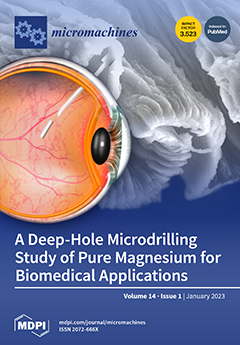To understand the influence of indigestible particles like particulate matter 2.5 (PM2.5) on macrophages, we examined the time course of the series phagocytosis of indigestible 2 μm polystyrene spheres (PS). Five kinds of antigens were used as samples for phagocytosis; Zymosan, non-coated 2
[...] Read more.
To understand the influence of indigestible particles like particulate matter 2.5 (PM2.5) on macrophages, we examined the time course of the series phagocytosis of indigestible 2 μm polystyrene spheres (PS). Five kinds of antigens were used as samples for phagocytosis; Zymosan, non-coated 2
m PS, bovine serum albumin (BSA)-coated PS (BSA-PS), IgG-coated PS (IgG-PS), and IgG-BSA-coated PS (IgG/BSA-PS). To keep the surrounding concentration of antigens against single macrophages constant, antigens flowed at a continuous rate of
μm/s within a culture dish as a free-flow measurement assay (on-chip free-flow method). The interval of series phagocytosis for IgG/BSA-PS was the shortest among five samples; it was six times faster than Zymosan in terms of engulfment frequency, and up to 50 particles were engulfed within two hours, maintaining constant intervals until reaching the maximum number. The rate of increase in the total number of phagocytozed IgG/BSA-PS over time was constant, at
particles/min, in series phagocytosis with a 33-cell population, indicating that the phagocytosis rate constant remained constant independent of the number of phagocytoses. Reaction model fitting of the results showed that IgG/BSA-PS had the highest efficiency in terms of the phagocytosis rate constant, 2.3 ×
particles/min, whereas those of IgG-PS, BSA-PS, PS, and Zymosan were 1.4 ×
, 1.1 ×
, 4.2 ×
, and 3.6 ×
particles/min, respectively. One-by-one feeding of IgG/BSA-PS with optical tweezers was examined to confirm the phagocytosis intervals, and we found that the intervals remained constant until several times before the maximum number of antigens for engulfment, also indicating no change in the phagocytosis rate constant regardless of the history of former phagocytosis and phagocytosis number. Simultaneous phagocytosis of two IgG-BSA-decorated microneedle engulfments also showed that the initiation and progress of two simultaneous engulfments on the two different places on a cell were independent and had the same elongation velocity. Therefore, each phagocytosis of indigestible antigens does not affect both in series or in simultaneous subsequent phagocytosis until reaching the maximum capacity of the phagocytosis number. The results suggest (1) no change in the phagocytosis rate constant regardless of the history of phagocytosis numbers and attachment timing and positions, and (2) IgG-BSA decoration of indigestible microparticles in blood accelerates their engulfment faster, resulting in a severe shortage of macrophages within the shortest time.
Full article






